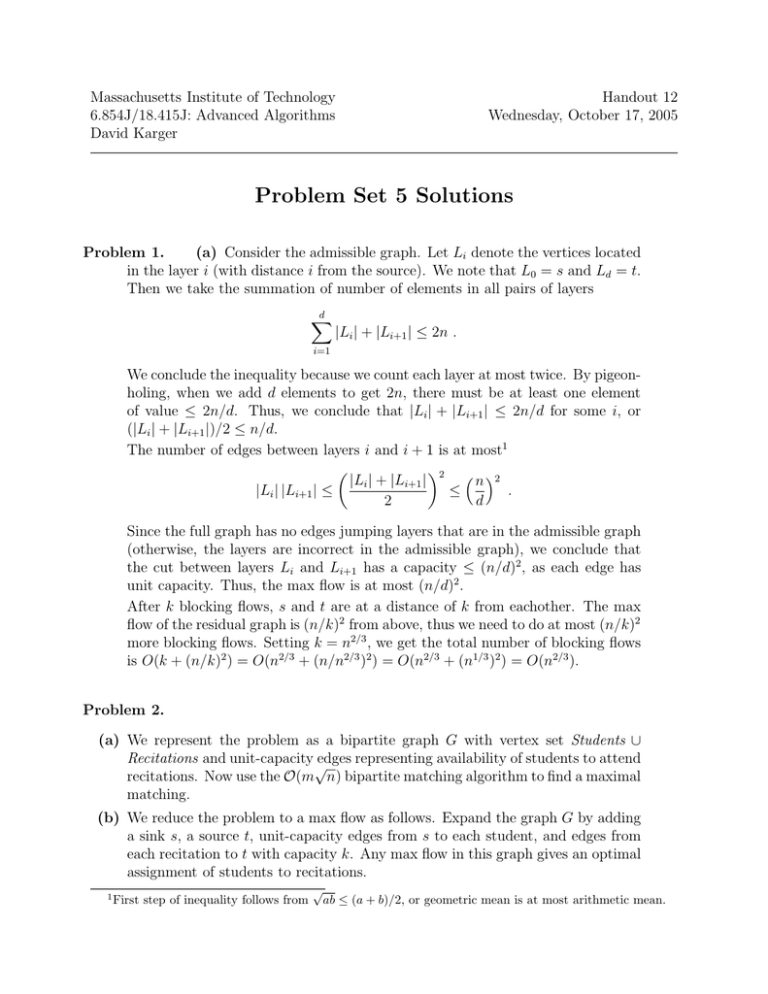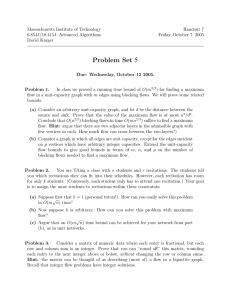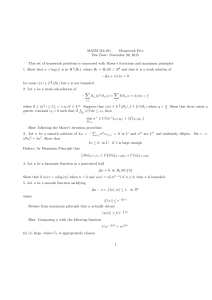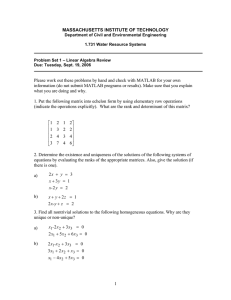Massachusetts Institute of Technology Handout 12 6.854J/18.415J: Advanced Algorithms
advertisement

Massachusetts Institute of Technology
6.854J/18.415J: Advanced Algorithms
David Karger
Handout 12
Wednesday, October 17, 2005
Problem Set 5 Solutions
Problem 1.
(a) Consider the admissible graph. Let Li denote the vertices located
in the layer i (with distance i from the source). We note that L0 = s and Ld = t.
Then we take the summation of number of elements in all pairs of layers
d
�
|Li | + |Li+1 | ≤ 2n .
i=1
We conclude the inequality because we count each layer at most twice. By pigeonholing, when we add d elements to get 2n, there must be at least one element
of value ≤ 2n/d. Thus, we conclude that |Li | + |Li+1 | ≤ 2n/d for some i, or
(|Li | + |Li+1 |)/2 ≤ n/d.
The number of edges between layers i and i + 1 is at most1
�
�2 � �
|Li | + |Li+1 |
n 2
|Li | |Li+1 | ≤
≤
.
2
d
Since the full graph has no edges jumping layers that are in the admissible graph
(otherwise, the layers are incorrect in the admissible graph), we conclude that
the cut between layers Li and Li+1 has a capacity ≤ (n/d)2 , as each edge has
unit capacity. Thus, the max flow is at most (n/d)2 .
After k blocking flows, s and t are at a distance of k from eachother. The max
flow of the residual graph is (n/k)2 from above, thus we need to do at most (n/k)2
more blocking flows. Setting k = n2/3 , we get the total number of blocking flows
is O(k + (n/k)2 ) = O(n2/3 + (n/n2/3 )2 ) = O(n2/3 + (n1/3 )2 ) = O(n2/3 ).
Problem 2.
(a) We represent the problem as a bipartite graph G with vertex set Students ∪
Recitations and unit-capacity √
edges representing availability of students to attend
recitations. Now use the O(m n) bipartite matching algorithm to find a maximal
matching.
(b) We reduce the problem to a max flow as follows. Expand the graph G by adding
a sink s, a source t, unit-capacity edges from s to each student, and edges from
each recitation to t with capacity k. Any max flow in this graph gives an optimal
assignment of students to recitations.
1
First step of inequality follows from
√
ab ≤ (a + b)/2, or geometric mean is at most arithmetic mean.
2
Handout 12: Problem Set 5 Solutions
(c) Suppose we remove blocking flows, so that the distance between source and sink
is ≥ . Each path in the residual graph has length ≥ and thus passes through
≥ −1
students (since the path must alternate student, recitation, student, recita2
= O( n )
tion, etc., before reaching the sink). Therefore, there exist ≤ 2|# students|
−1
n
disjoint
√ paths from source
√ to sink, so additional blocking flows suffice. Setting
= n, this gives O( n) total blocking flows.
Each blocking flow can be computed in O(m) time using the same advance-retreat
DFS algorithm as for unit capacity graphs. This is because the only non-unit
capacity edges are the edges from recitations to the sink, and we only advance
to the sink on the√last step of the blocking-flow algorithm. The overall running
time is thus O(m n).
Problem 3. Let A = (aij ) be an n × n matrix
with fractional entries such that all row and column sums are integral. Without loss of
generality, we assume that 0 ≤ aij < 1 for all i, j ∈ {1, ..., n}. (We can subtract aij from
each aij , perform the procedure below, and add back the same amount afterwards.)
Consider the graph G with vertex set {s, t} ∪ {vij : i, j ∈ {1, ..., n}} ∪ {r1 , ..., rn } ∪ {c1 , ..., cn }
where the r’s and c’s represent the rows and columns of A, respectively. For all i, j ∈
{1, ..., n}, let there be edges:
�
• (s, ri) with capacity j � aij � ,
�
• (cj , t) with capacity i� ai� j ,
• (ri , vij ) and (cj , vij ) with capacity aij , i.e., 0 if aij = 0 and 1 otherwise.
�
Consider the s-t cut (S, T ) where S = {s}. Clearly the value of this cut is i,j aij . Now
consider the flow f where:
�
• f (s, ri) = j � aij � ,
�
• f (cj , t) = i� ai� j ,
• f (ri, vij ) = f (vij , cj ) = aij .
�
f has value i,j aij , the same as the min cut. Therefore, f is a max flow.
Note that G has integral capacities, so G has an integral max flow g. Let B = (bij ) be the
n × n matrix where bij = g(ri, vij ). B is the desired integral matrix.






![1. Let R = C[x].](http://s2.studylib.net/store/data/010491179_1-9a9c70e395518f466f652079f02ae14a-300x300.png)
